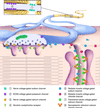Ion channel genes and human neurological disease: recent progress, prospects, and challenges
- PMID: 10220366
- PMCID: PMC34105
- DOI: 10.1073/pnas.96.9.4759
Ion channel genes and human neurological disease: recent progress, prospects, and challenges
Abstract
What do epilepsy, migraine headache, deafness, episodic ataxia, periodic paralysis, malignant hyperthermia, and generalized myotonia have in common? These human neurological disorders can be caused by mutations in genes for ion channels. Many of the channel diseases are "paroxysmal disorders" whose principal symptoms occur intermittently in individuals who otherwise may be healthy and active. Some of the ion channels that cause human neurological disease are old acquaintances previously cloned and extensively studied by channel specialists. In other cases, however, disease-gene hunts have led the way to the identification of new channel genes. Progress in the study of ion channels has made it possible to analyze the effects of human neurological disease-causing channel mutations at the level of the single channel, the subcellular domain, the neuronal network, and the behaving organism.
Figures


References
-
- Charlier C, Singh N A, Ryan S G, Lewis T B, Reus B E, Leach R J, Leppert M. Nat Genet. 1998;18:53–55. - PubMed
-
- Singh N A, Charlier C, Stauffer D, DuPont B R, Leach R J, Melis R, Ronen G M, Bjerre I, Quattlebaum T, Murphy J V, et al. Nat Genet. 1998;18:25–29. - PubMed
-
- Biervert C, Schroeder B C, Kubisch C, Berkovic S F, Propping P, Jentsch T J, Steinlein O K. Science. 1998;279:403–406. - PubMed
-
- Scheffer I E, Berkovic S F. Brain. 1997;120:479–490. - PubMed
-
- Wallace R H, Wang D W, Singh R, Scheffer I E, George A L, Jr, Phillips H A, Saar K, Reis A, Johnson E W, Sutherland G R, et al. Nat Genet. 1998;19:366–370. - PubMed
Publication types
MeSH terms
Substances
LinkOut - more resources
Full Text Sources
Other Literature Sources
Medical

